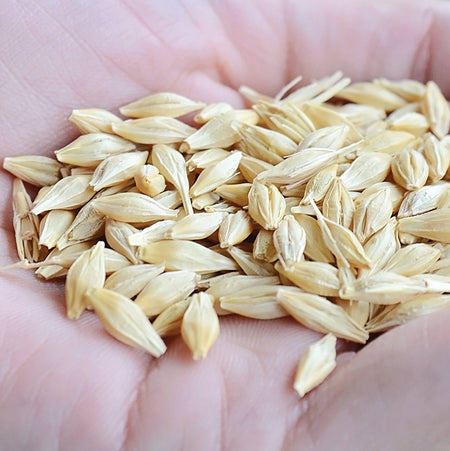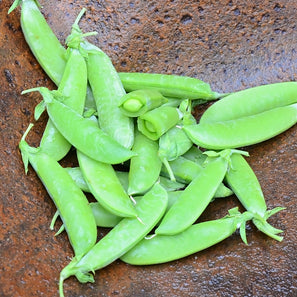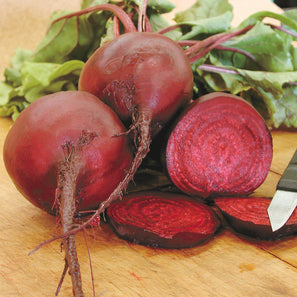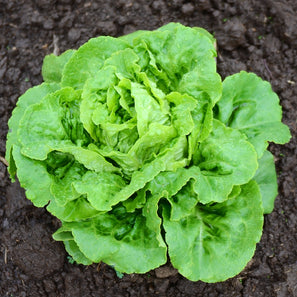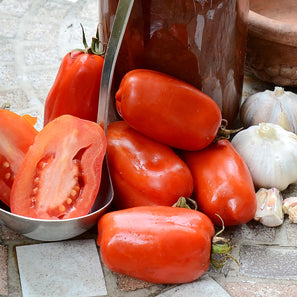FULL PINT BARLEY
Product Description:
| Soil Temp for Germ | 45-75°F |
| Days to Emergence | 5-15 |
Culture
• Grains require modest levels of nutrition to produce good quality proteins
• Excessive soil fertility will cause lower protein levels and may lead to lodging (heavy heads falling over)
• Winter varieties require cold temperatures in order to produce seed heads (vernalize) in spring; they should be planted in the fall
Direct Sowing
• Plant mid-September through mid-October
• For the smaller-scale grower, broadcast the seed over the surface of the soil and rake in to ensure good soil contact
• Recommended seeding rate: 3 1/2 lbs per 1000 square feet
• Seed can also be drilled at 2 1/2 lbs per 1000 square feet—plant 1-2 inches deep
• Mulch with clean straw or leaves to 4 inches
Insects & Diseases
• Common insects: aphids, thrips
• Insect control: Pyrethrin
• Common diseases: stripe rust, stem rust, powdery mildew
• Disease prevention: plant disease resistant varieties, for powdery mildew use Zonix
Harvest & Storage
• Both winter and spring varieties of grains are generally ready for harvest in August
• Timing the harvest to ensure optimal moisture level reduces loss to shatter or grain resprouting—seed heads should be dry and resist denting by fingernail (ideal moisture content is 13% or less)
• Small-scale wheat growers can use a hand sickle to harvest—tie into bundles, called "shocks," and stack upright in the field to dry before threshing
• “Hulless” varieties can easily be cleaned by hand-threshing and winnowing; other varieties may require flailing or mechanical threshing
• Store in airtight containers in a cool, dry location
These more detailed cultural instructions are for small grains wheat, oats, spelt and flax.
In general, grains require modest levels of nutrition and water to produce a good crop. Highly fertile soils tend to produce grains with a high yield but lower nutritional quality. Grains grown in high fertility soil may also “lodge” or fall over. When this happens, it becomes very difficult to harvest. We suggest you test your soil to know what components are out of balance. Moderate to high levels of potassium and phosperous and moderate levels of nitrogen are fine for most grains. One pound of a complete organic fertilizer per 100 square feet is generally enough for the crop during the growing season.
Irrigation: Historically, the grains we offer are native to the Fertile Crescent, an area of low annual rainfall now part of Iran, Iraq and Turkey. In the big grain producing areas of the mid and upper Midwest regions of the US, grains are grown without irrigation (dry farming). The soils there tend to be a bit dryer, which is fine for most small grains. Good soaking rains or watering are needed periodically to produce a good crop. A minimum of 8-10 inches of water per year is needed for good yields. Remember to let the soil surface dry out between watering to help prevent diseases. Avoid heavy watering when the plants are pollinating or after the grain naturally starts to dry and mature.
Soil Preparation: If possible, the soil should be prepared in the fall and the sowing done in early spring. If you can till and water the soil in the fall, allow the weeds to sprout and rake or till again to kill the weed seedlings. By following this protocol, your weed problems will be much less the following year. If working your soil in the fall is not possible, work the soil as early in the spring as you can and rake smooth. Early sowings around the date of your last frost or a week prior will get you crop off to an early start before the weeds. An early seeded vigorous stand of grain will go along way to choke out any weeds that germinate later after the soil has warmed.
Sowing: Small grains are generally more tolerant to cool wet soils than other garden crops. Most will sprout in soil temperatures of 45-50oF and are tolerant to light frosts. Seeding small grains can be accomplished a couple of ways. One method is to dig a shallow 1-2 inch deep furrow and sow the seed like carrot seed, about ½ to 1 inch between seeds. Rake the soil into the furrows and keep moist. Space your furrows about 5-6 inches apart. A faster way to sow is to broadcast the seed by hand using the “feeding the chickens” method or by using a drop spreader. In our experience, a drop spreader works best. They are inexpensive and spread the seed uniformly. We use a 30-inch spreader and leave a 1-foot walkway between rows. Mix the seed 1:1 with a medium-grade vermiculite and start with the lowest setting. After seeding a few feet, stop and look at your seedbed. You want an average of 1 seed every 2 square inches. Open the spreader further to seed heavier or mix in more vermiculite to seed lighter. It is helpful to lightly rake the seedbed after sowing to ensure that the seed is in good contact with the soil. Water lightly and keep moist. Germination is generally fast, in about 3-6 days. Watch out for birds. Flash tape will generally keep most birds away. If the birds continue to be a problem, you can cover the rows with a floating row cover until the seed has germinated. The drop spreader gives you nice rows that can be easily covered. A plot 10 feet by 100 feet will yield approximately 1 bushel of grain. Plan on sowing 2 pounds of seed per 1,000 square feet. Trial and error will be your best guide.
Weed Control: The more weed-free you keep a piece of ground from the beginning, the less weed problems you will have in the future. One good crop of weeds has the ability to produce a weed seed crop that can lie dormant in the ground for years. Timely grain sowings are also be a big help. Grains sown early will out-compete many weeds. Because the grains are planted so close together, hand-pulling weeds is your best control.
Grain Growth and Development: Grains in the grass family, like wheat or oats, will produce side shoots at the surface of the ground. This “stooling” or “tillering” will produce more stalks and mature heads and greatly increased the total yield. Early planting and light grazing can encourage stooling. Make sure if you are going to let the cows or sheep graze your wheat or oats that the soil is dry and only let them go over it once lightly.
Pollination: Most small grains are essentially self-pollinated. Hot temperatures and/or rain at the time of pollination can reduce successful pollination. Bees are not necessary. Because pollination takes place in a relatively short period of time, cross pollination between varieties planted next to one another is rare although is possible if both varieties are releasing pollen on the same day.
Variety Selection: The varieties we have selected are all public domain varieties that were bred by private breeders or land grant colleges (state universities). There are literally hundreds of varieties of each type of grain, each slightly
different for a specific growing region or a specific end use. We have selected varieties that are the very best for their intended use.
Harvest: Once the stalks, leaves and heads have become golden brown, begin checking the hardness of the kernels. To do this, take a head of wheat and rub it between your hands to break the kernels loose from the chaff and gently blow the chaff away. Pop the kernels in your mouth and bite the kernels. They should be fairly hard and have a bit of a crunch. If they are soft or squishy, then the kernels are still in the dough stage and need a few more days to dry. The grain will rot if harvested at this stage. Cut your grain when the kernels are dry. If you have access to a scythe and know how to use it, this is a good way to cut your grain. Other ways include mowing with a sickle mower or using a weed eater. Once cut, the grain should promptly be bundled and stored in a dry location until threshing.
Threshing: The removal of seed from the heads can be done any number of ways. Some grains, like flax, thresh out very easily; others, like wheat, require a bit more effort. A time-honored method of threshing is flailing the grain. This is accomplished by laying the cut grain out on a floor or other hard surface that can be swept. Then literally beat the grain with a flail to separate the grain kernels from the straw and chaff. A flail can be made from old broomsticks. Make a handle 4-5 feet long. At the flail end, attach a loop of light rope. It works best to drill a hole through the stick rather than attaching it with screws. To finish the beater end of the flail, cut a piece of broom handle 1-2 feet in length. Attach a loop of light rope to the shorter piece like you did to the long piece. Loop the rope of the beater through the loop on the handle and tie a knot. The flail is now ready to use. When finished, sweep the threshed grain off the floor and pour it in buckets. Another threshing method is to cut the heads from the straw and place the heads into a tightly woven cloth bag. Then knead the bag like bread dough. The kneading action breaks the kernels loose from the chaff. After the grain has been threshed, you can use a fan to blow the chaff away from the grain. If you have a place to thresh outdoors, you can do this on a breezy day and let the wind blow the chaff and straw to one side. Pouring the grain in front of a fan will help remove the rest of the chaff.
Storage: Threshed dry grain should be stored in airtight plastic buckets or large glass jars in a cool dry location. If you want to store it for more than a month, we highly recommend placing a desiccant pack in each container. If you have the space, storing grain in a freezer is the best method. Freezing grain helps prevent the outbreak of Indian meal moths, or pantry moths as they are more commonly known. Putting a tablespoon of diatomaceous earth in each 5-gallon container will also discourage insects. Diatomaceous earth is completely non-toxic and can easily be removed by screening the seed prior to grinding.
Wheat: Nowadays, millers blend several varieties of wheat together to get the best flour for any given purpose. We have selected wheats that will produce good bread flour. In general, wheat prefers a heavier soil with at least 2% organic matter. Wheat is more tolerant of higher pH soils than acid soils (lower pH). On average, there are 12,000 seeds per pound but this figure will vary between varieties. Germination rates for freshly harvested wheat are usually lower than germination rates of wheat that has been stored 6-18 months. Wheat seed will remain viable for up to ten years if stored properly.
Oats: Only specific varieties of oats are suitable for human consumption. Leave the horse oats for the horses! Oats are generally very tolerant of a wide range in soil types but better yields require higher fertility. Sow 3 pounds of seed per 1,000 square feet. The average seed count is 8,000 seeds per pound. Oats will remain viable for up to 7 years when stored properly.
Flax: Flax will tolerate poorer soil than any other small grain but yields will be less with lower fertility. Sow 1 pound per 1,000 square feet. Because of the high oil content of flax, it is best stored in a refrigerator to prevent the oils in the seed from going rancid. Average seed count is 20,000 seeds per pound. Flax will remain viable for up to 5 years when stored properly.
Spelt: Our variety of spelt is meant to be fall sown in early September. The Spelt will go dormant for the winter and head up early in the spring. Spelt has different proteins than wheat and many people who are allergic to wheat can tolerate spelt flour. It requires the same soil types and fertility as wheat. On average there are 11,000 seed per pound and spelt will remain viable for up to 10 years.

